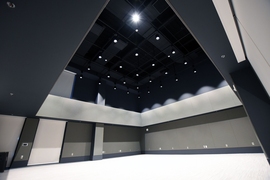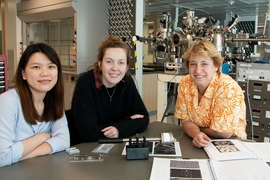On Sept. 16 MIT.nano hosted an informal public conversation with physicist Don Eigler, Kavli Laureate and former fellow of the IBM Almaden Research Center. The conversation marked the fifth and final event in the MIT.nano “Perspectives in Nanotechnology” seminar series, which began in the spring.
Eigler was the founding leader of the Low Temperature Scanning Tunneling Microscopy Project at IBM. Among his accomplishments, he is recognized for his 1989 experiment in which he became the first person to manipulate individual atoms with precision, using a scanning tunneling microscope to spell out “I-B-M” from 35 individual xenon atoms. He is also known for creating the first quantum corrals.
“Nature is not boring. If as an experimentalist you invent something that allows you to see something no one has seen before, you will find something interesting,” he told an audience of faculty, graduate students, alumni, and others.
Following the conversation, MIT.nano and the Graduate Student Council hosted an exhibition featuring microscopy artwork by the MIT community.
Organized by Farnaz Niroui, MIT assistant professor of electrical engineering and computer science, the “Perspectives in Nanotechnology” series featured a set of five lectures by experts who offered insight into current research and future directions based on their experiences in the field of nanoscience and nanotechnology.
“This series was a great way to introduce MIT.nano not just as a nanoscale research facility, but as a place where we can have discussions around nanoscience and its different applications across disciplines within our community,” says Niroui. “Having these five pioneers talk about their research trajectories, and where they see the field of nanotechnology going in the future, has been inspiring.”
The first four speakers in the series were:
March 18: Roger Howe of Stanford University
Roger Howe is the William E. Ayer Professor of Engineering at Stanford University. He was the faculty director of the Stanford Nanofabrication Facility from 2009 to 2017 and director of the National Science Foundation’s National Nanotechnology Infrastructure Network from 2011 to 2015.
For the first presentation in the series, Howe discussed “the role that shared academic nano facilities, such as nano@Stanford and MIT.nano, can play in nucleating the tools and processes, as well as the community of internal and external researchers, that can accelerate the commercialization of nanotechnology.”
April 29: Paul Alivisatos of the University of California at Berkeley
Paul Alivisatos is the University of California at Berkeley's executive vice chancellor and provost, and Samsung Distinguished Professor of Nanoscience and Nanotechnology. He is also the director emeritus of Lawrence Berkeley National Laboratory, founding director of the Kavli Energy Nanoscience Institute, and a founder of two prominent nanotechnology companies.
In his talk, Alivisatos discussed his research on colloidal nanocrystals, one of the several artificial building blocks for nanoscience and nanotechnology. He reflected on the question, “What will happen when artificial nanocrystals can be observed and controlled at the level of single atoms?”
May 16: Eli Yablonovitch of the University of California at Berkeley
Eli Yablonovitch is a professor of electrical engineering and computer science at UC Berkeley, where he holds the James and Katherine Lau Chair in Engineering. Regarded as a father of the photonic bandgap concept, Yablonovitch coined the term "photonic crystal" and has significantly contributed to the fields of strained semiconductor lasers and photovoltaics.
Yablonovitch is the director of the National Science Foundation Center for Energy Efficient Electronics Science, a multi-university center headquartered at Berkeley. For his perspectives presentation, he addressed the question, "What new device will replace the transistor?"
June 19: Robert Langer of MIT
Robert Langer is the David H. Koch Institute Professor at MIT. Author of more than 1,250 articles, he also has nearly 1,050 patents worldwide. He is the most-cited engineer in history.
In a presentation entitled, “From Microtechnology to Nanotechnology: New Ways to Discover and Deliver Medicine to Treat Disease,” Langer addressed the numerous new technologies being developed that may impact the future of medicine.
MIT.nano and Niroui will now kick off a continuing monthly seminar series exploring the frontiers of nanoscience and nanotechnology. For more information, visit mitnano.mit.edu.











